1993 JEWEL & GLITTER BARBIE Mattel sequins vest skirt tri-lingual box 90s Selena
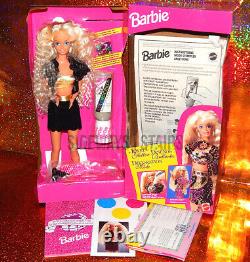
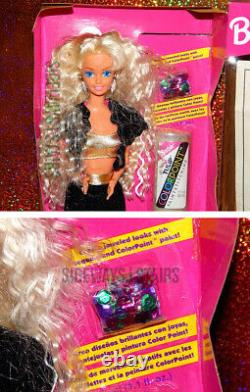
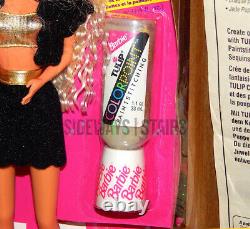
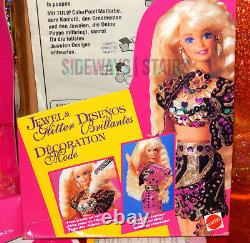
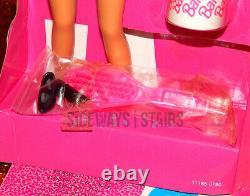
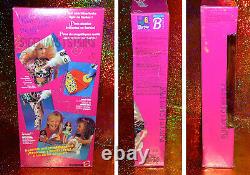
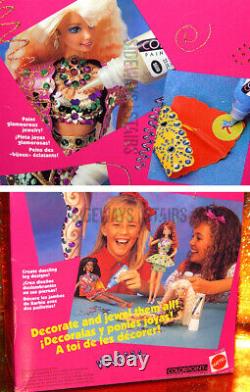
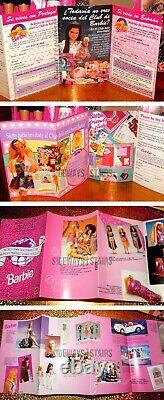
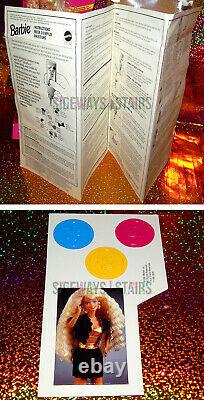
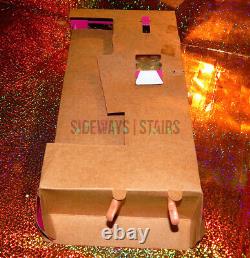
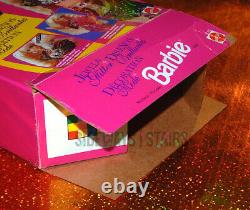



Check out our other new & used items>>>>> HERE! 1993 JEWEL & GLITTER BARBIE BY MATTEL. Remind you of superstar singer, Selena? Barbie must love Selena and her fashion choices because this outfit, when decorated, is totally Selena's style.
Barbie's outfit is reversible so you can have twice the fun painting, stenciling shapes, and sequining. Barbie comes with a black vest and skirt with gold accents, gold earrings, black pumps, pink hairbrush, Colorpoint Paintstitching glitter paint, and various sequins. In rare, foreign tri-lingual box! Not suitable for children under 36 months. Contains small parts which could be swallowed.
Unused with opened, damaged box/packaging. The doll is unused and the glitter paint and sequins are still sealed.
The packaging does not include the plastic ties that hold Barbie in the box. ALL PHOTOS AND TEXT ARE INTELLECTUAL PROPERTY OF SIDEWAYS STAIRS CO. Barbie is a fashion doll manufactured by the American toy company Mattel, Inc. And launched in March 1959.
American businesswoman Ruth Handler is credited with the creation of the doll using a German doll called Bild Lilli as her inspiration. Barbie is the figurehead of a brand of Mattel dolls and accessories, including other family members and collectible dolls. Barbie has been an important part of the toy fashion doll market for over fifty years, and has been the subject of numerous controversies and lawsuits, often involving parodies of the doll and her lifestyle. However, sales have declined sharply since 2014. [1] The doll transformed the toy business in affluent communities worldwide by becoming a vehicle for the sale of related merchandise accessories, clothes, friends of Barbie, etc.
She had a significant impact on social values by conveying characteristics of female independence, and with her multitude of accessories, an idealized upscale life-style that can be shared with affluent friends. [2] Starting in 1987, Barbie has expanded into a media franchise, including animated films, television specials, video games, and music... Ruth Handler watched her daughter Barbara play with paper dolls, and noticed that she often enjoyed giving them adult roles. At the time, most children's toy dolls were representations of infants. Realizing that there could be a gap in the market, Handler suggested the idea of an adult-bodied doll to her husband Elliot, a co-founder of the Mattel toy company. He was unenthusiastic about the idea, as were Mattel's directors. During a trip to Europe in 1956 with her children Barbara and Kenneth, Ruth Handler came across a German toy doll called Bild Lilli. She gave one to her daughter and took the others back to Mattel.The Lilli doll was based on a popular character appearing in a comic strip drawn by Reinhard Beuthin for the newspaper Bild. Lilli was a blonde bombshell, a working girl who knew what she wanted and was not above using men to get it. Upon her return to the United States, Handler redesigned the doll (with help from engineer Jack Ryan) and the doll was given a new name, Barbie, after Handler's daughter Barbara. The doll made its debut at the American International Toy Fair in New York on March 9, 1959.
[5] This date is also used as Barbie's official birthday. The first Barbie doll wore a black and white zebra striped swimsuit and signature topknot ponytail, and was available as either a blonde or brunette. The doll was marketed as a "Teen-age Fashion Model, " with her clothes created by Mattel fashion designer Charlotte Johnson.
The first Barbie dolls were manufactured in Japan, with their clothes hand-stitched by Japanese homeworkers. Louis Marx and Company sued Mattel in March 1961. After licensing Lilli, they claimed that Mattel had infringed on Greiner & Hausser's patent for Bild-Lillis hip joint, and also claimed that Barbie was "a direct take-off and copy" of Bild-Lilli.
The company additionally claimed that Mattel "falsely and misleadingly represented itself as having originated the design". Mattel counter-claimed and the case was settled out of court in 1963. Ruth Handler believed that it was important for Barbie to have an adult appearance, and early market research showed that some parents were unhappy about the doll's chest, which had distinct breasts. Barbie's appearance has been changed many times, most notably in 1971 when the doll's eyes were adjusted to look forwards rather than having the demure sideways glance of the original model. Barbie was one of the first toys to have a marketing strategy based extensively on television advertising, which has been copied widely by other toys.
The standard range of Barbie dolls and related accessories are manufactured to approximately 1/6 scale, which is also known as playscale. [9] The standard dolls are approximately 11½ inches tall...
Barbie has become a cultural icon and has been given honors that are rare in the toy world. In 1974, a section of Times Square in New York City was renamed Barbie Boulevard for a week. The Musée des Arts Décoratifs, Paris at the Louvre held a Barbie exhibit in 2016. The exhibit featured 700 Barbie dolls over two floors as well as works by contemporary artists and documents (newspapers, photos, video) that contextualize Barbie. In 1986, the artist Andy Warhol created a painting of Barbie.
In 2015, The Andy Warhol Foundation then teamed up with Mattel to create an Andy Warhol Barbie. Outsider artist Al Carbee took thousands of photographs of Barbie and created countless collages and dioramas featuring Barbie in various settings. [14] Carbee was the subject of the feature-length documentary Magical Universe. Carbee's collage art was presented in the 2016 Barbie exhibit at the Musée des Arts Décoratifs, Paris in the section about visuals artists who have been inspired by Barbie. In 2013, in Taiwan, the first Barbie-themed restaurant called "Barbie Café" opened under the Sinlaku group. The Economist has emphasized the importance of Barbie to children's imagination. From her early days as a teenage fashion model, Barbie has appeared as an astronaut, surgeon, Olympic athlete, downhill skier, aerobics instructor, TV news reporter, vet, rock star, doctor, army officer, air force pilot, summit diplomat, rap musician, presidential candidate (party undefined), baseball player, scuba diver, lifeguard, fire-fighter, engineer, dentist, and many more.... When Barbie first burst into the toy shops, just as the 1960s were breaking, the doll market consisted mostly of babies, designed for girls to cradle, rock and feed. By creating a doll with adult features, Mattel enabled girls to become anything they want. Selena Quintanilla-Pérez (Spanish: [selena kintania pees]; April 16, 1971 March 31, 1995) was an American singer, songwriter, spokesperson, model, actress, and fashion designer. Called the Queen of Tejano music, her contributions to music and fashion made her one of the most celebrated Mexican-American entertainers of the late 20th century. [2] Media outlets called her the "Tejano Madonna" for her clothing choices. [a] She also ranks among the most influential Latin artists of all time and is credited for catapulting a music genre into the mainstream market. The youngest child of the Quintanilla family, she debuted on the music scene in 1980 as a member of the band Selena y Los Dinos, which also included her elder siblings A.Selena began recording professionally in 1982. In the 1980s, she was often criticized and was refused bookings at venues across Texas for performing Tejano musica male-dominated music genre. However, her popularity grew after she won the Tejano Music Award for Female Vocalist of the Year in 1987, which she won nine consecutive times. Selena signed with EMI Latin in 1989 and released her self-titled debut album the same year, while her brother became her principal music producer and songwriter. Selena released Entre a Mi Mundo (1992), which peaked at number one on the US Billboard Regional Mexican Albums chart for eight consecutive months.
The album's commercial success led music critics to call it the "breakthrough" recording of her musical career. One of its singles, "Como la Flor", became one of her most popular signature songs. (1993) won Best Mexican/American Album at the 1994 Grammy Awards, becoming the first recording by a female Tejano artist to do so. It was critically acclaimed as being responsible for Tejano music's first marketable era as it became one of the most popular Latin music subgenres at the time.
Amor Prohibido has been ranked among the most essential Latin recordings of the past 50 years by Billboard magazine while the publication nominated it for its list of the top 100 albums of all-time. It ranked number 19 on NPR's list of the 150 greatest albums made by women.
Aside from music, Selena was active in her community and donated her time to civic causes. Coca-Cola appointed her its spokesperson in Texas. Selena became a sex icon; she was often criticized for wearing suggestive outfits in light of her comments about being a role model for young women. Selena and her guitarist, Chris Pérez, eloped in April 1992 after her father raised concerns over their relationship.On March 31, 1995, Selena was shot and killed by Yolanda Saldívar, her friend and former manager of her Selena Etc. Saldívar was cornered by police when she attempted to flee, and threatened to kill herself, but was convinced to give herself up and was sentenced to life in prison with a possible parole after 30 years. Two weeks later, George W.
Bushgovernor of Texas at the timedeclared Selena's birthday Selena Day in Texas. Her posthumous crossover album, Dreaming of You (1995), debuted atop the Billboard 200, making Selena the first Latin artist to accomplish this feat. Released Selena, a film about her life and career, which starred Jennifer Lopez as Selena and Lupe Ontiveros as Saldívar. Selena's sister Suzette found Selena and Pérez flirting with each other and immediately informed their father. Took Pérez off the bus and told him his relationship with Selena was over. [61] Selena and Pérez continued their relationship despite Quintanilla, Jr's disapproval;[62][63] Selena's mother Marcella approved of their relationship. Saw Selena and Pérez romantically together on the bus after he informed them of his disapproval; he pulled over and an argument between Quintanilla, Jr. He called Pérez a "cancer in my family" and threatened to disband the group if they continued their relationship. [65] Selena and Pérez relented; Quintanilla, Jr.Fired Pérez from the band and prevented Selena from leaving with him. [66] After his dismissal, Pérez and Selena secretly continued their relationship. On the morning of April 2, 1992, Selena and Pérez decided to elope, believing Quintanilla, Jr.
Would never approve of their relationship. [65][67] Selena thought Quintanilla, Jr. Would have to accept them if they were married, and would not have to hide their feelings for each other. Within hours of their marriage, the media announced the couple's elopement.
[68] Selena's family tried to find her; Quintanilla, Jr. Did not take the news well and alienated himself for some time. [68] Selena and Pérez moved into an apartment in Corpus Christi. [69] In interviews, Quintanilla, Jr.
Expressed how he feared Pérez could be a machista (Spanish for a male chauvinist), who would force Selena to end her career and music goals, a move that prevented Quintanilla, Jr. To accept Pérez as being suitable for Selena at the time. Later approached Pérez, apologized, accepted the marriage, and took Pérez back into the band. A month after her elopement, Selena released her third studio album, Entre a Mi Mundo, in May 1992.
The album was critically acclaimed as her "breakthrough album". [77] Entre a Mi Mundo became the first Tejano album by a female artist to sell over 300,000 copies.
[b] Selena was booked for a high-profile border press tour in Monterrey, Mexico, with music media types in a meet-and-greet conference. [79] At the time, Tejanos were looked down on as "hayseed pochos" among Mexican citizens. The singer's Spanish was far from fluent;[79] EMI Latin executives were "terrified" about the singer's limited Spanish during the press conference for the album in Mexico. [80] According to Patoski, Selena "played her cards right" during the conference and won over the Mexican media after newspapers hailed her as "an artist of the people". The newspapers found her to be a refreshing change from Mexican telenovela actors who were fair-skinned, blond-haired, and green-eyed. [81] After her publicity press, Selena was booked to play at several concerts throughout Mexico, including a performance at Festival Acapulco in May 1993, which garnered her critical acclaim. [82] Her performance in Nuevo Leon on September 17, 1993 was attended by 70,000 people, garnering her the title of the biggest Tejano act in Mexico. [81] The album produced four singles; "Como la Flor", ¿Qué Creías? "Como la Flor" became Selena's signature recording;[83] it was critically acclaim by music critics as a career launcher for Selena. [84] "Como la Flor" helped Selena to dominate the Latin music charts and become immensely popular in Mexico where Mexican-Americans were generally not liked among citizens which was well received by critics.[85] The track was nominated for Song of the Year at the 1993 Tejano Music Awards. [86] The single peaked at number six on the US Billboard Top Latin Songs chart. A year after Entre a Mi Mundo; it was recorded during a free concert at the Memorial Coliseum in Corpus Christi, on February 7, 1993.
[89] The album included previously released tracks that were sung live and three studio recordings; "No Debes Jugar", "La Llamada", and "Tú Robaste Mi Corazón" a duet with Tejano musician Emilio Navaira. The tracks "No Debes Jugar" and "La Llamada" peaked within the top five on the US Billboard Top Latin Songs chart. Won the Grammy Award for Best Mexican/American Album at the 36th Grammy Awards.[78] In May 1994, Live! Was named Album of the Year by the Billboard Latin Music Awards. [91] At the 1994 Tejano Music Awards, Live! Won Album of the Year, [92] while at the 1994 Lo Nuestro Awards, it was nominated for Regional Mexican Album of the Year. [76][94] Selena briefly appeared opposite Erik Estrada in a Mexican telenovela titled Dos Mujeres, Un Camino.
[53] In 1995 she entered negotiations to star in another telenovela produced by Emilio Larrosa. [53] She appeared in two episodes, which garnered record ratings for the series... Selena's vocal range was soprano. [185] In an April 1995 interview with Billboard magazine, Behar said he saw Selena as a "cross between Janet Jackson and Whitney Houston in style, feel, and vocal range".
[186] Although Selena did not write most of her songs, she incorporated R&B, [187] Latin pop, technopop, [188] country and western, and disco into her Tejano music repertoire. [189] Mario Tarradell of The Dallas Morning News said that during her music career, Selena "merges Tejano's infectious cumbia rhythm with street-savvy R&B, old-school soul, dancehall reggae, sizzling salsa, and trippy, loopy funk". [190] Selena's recordings expressed "love and pain, as well as strength and passion", according to Charles Tatum.
[191] She also recorded independently driven, female-empowerment-themed compositions; "Si La Quieres", ¿Qué Creías? ", "Ya Ves" and "Ya No, which centered around inappropriate relationships and recovery from domestic violence. [192] Peter Watrous of The New York Times said Selena's voice "sometimes quivered", and that she "roughed it up a bit". He continued, "[a]t its best, it had a coolness, a type of unadorned passion". [193] Ilan Stavans called her music "cursi-melodramatic, cheesy, overemotional, not too far from Juan Gabriel and a relative of Iglesias".
[194] Richard Corliss of Time magazine said her songs "are perky, cheerful rather than soulful", and that earlier recordings, "with their tinny, Tijuana Brass charts, and keyboards that evoke calliopes, are ideal for the fairground or merry-go-round". Corliss calls Selena's singing an expert mimicry of everything from Édith Piaf's melodramatic contralto to the coloratura riffs of Mariah Carey.But the sounds are still lightly Hispanic. Newsweek magazine called Selena's English-language recordings "a blend of urban pop and Latin warmth". [196] According to Texas Monthly, Selena's brother modernized her music into a more "funk and hip hop" sound.
Wrote increasingly cumbia-influenced songs for Ven Conmigo (1990); Ramiro Burr of Billboard said Selena and her band had "evolved a rhythmic style that demonstrated its increasing prowess for catchy cumbias such as'Baila Esta Cumbia' and the title track". [200] Italian essayist Gaetano Prampolini wrote that "Selena's voice projected a sonorous warmth and joyfulness" during her review of Selena's cumbia recordings. [201] In his review of the remix album Enamorada de Ti (2012), Stephen Thomas Erlewine of AllMusic wrote that Selena's songs were "rooted in the'90s and sound that way"... Sought to maintain Selena's image clean and family-oriented. [203] In 1989, she was offered sponsorship from beer companies but her father turned them down.[167] Selena was often refused gigs at Tejano venues because she was a female singer in a male-dominated music scene. [204] Manuel Peña wrote that after 1989, Selena's popularity increased and she became a sex icon following the release of her debut album. [203] Charles Tatum said Selena drew most attention from her "beauty, sexuality, and youthful impact on the Tejano music scene". [191] Selena said she never wanted to record explicit songs because of her upbringing and because her fan base consisted largely of young children, who regarded her as a role model.
[205] She further commented on the question of her sexual appeal to men during her crossover attempt, asserting that she will "stay the same" and that her English-language recordings will refrain from foul language and sexual themes. [205] In 1997, María Celeste Arrarás wrote in her book about Selena's death that the singer was a "sweet and charismatic girl".
[206] According to Arrarás, Selena "trusted everyone"; she often went shopping alone, despite her father's concerns over her safety. Betty Cortina of People magazine said Selena's provocative choice of clothing was an acceptable emulation of Janet Jackson and Madonna, and that she wore "sexy outfits that [accentuated] a body of a Latina woman". [167][208] Cortina also stated that Selena had a "flamboyant style, an unbelievable body, curves and booty".
[167] Arrarás wrote that Selena "began wearing clothes designed to emphasize her curvaceous figure" and that she "never came across as cheapsimply sexy". [209] She also said Selena's makeup regimen was not being "painted up or vulgar".
[209] Arrarás also noted Selena's "fun-loving stage manner" and said she was "playful onstage and off". Meier wrote in his book The Mexican American Experience: An Encyclopedia (2010) that Selena exhibited "contagious energy" during her concerts and said she displayed "warmth, passion, and sexuality" while exuding a "down-to-earth persona of the wholesome young girl next door". [211] Selena wore outfits that accented her physical attributes and was not afraid to wear outfits she liked, [167] despite criticism from parents who thought Selena's choice of outfits were inappropriate for young girls, who began emulating Selena.
[212] Her views on public image in the fashion industry were bothersome; she said she was opposed to the image that all woman should be "rail-thin" and the notion that they must wear certain outfits and be "super-young to be beautiful". In the early 1990s, Selena began wearing decorative bustiers, spandex or tight pants, and attractive, unbuttoned jackets during her concerts. [212] She was inspired by Paula Abdul, Janet Jackson, and Madonna.
[212] During a 1992 interview, Selena said her choice of clothing does not reflect her personality. [167] NBC News called Selena's outfit "provocative". [214] Because of her choices of outfits and dance moves, she was named by her fans as the "Mexican Madonna". [215][216] According to Suzette, Selena often designed and sewed her own outfits backstage with her designers, moments before she was due on stage. Disapproved of Selena's outfits, but he later accepted it when Selena discussed about it being a fashion trend.
[167] Selena became an inactive member of the Jehovah's Witnesses due to her exotic clothing. [217] During the photo shoot for Entre a Mi Mundo (1992), a photographer remarked on the ways Selena's choice of clothing affected Quintanilla, Jr. Tremendously; he often left sessions when Selena appeared in revealing outfits.
[218] Selena was credited as the first woman to change public perceptions of feminine beauty in the Tejano market; a feminist, she blazed a trail for other female artists during her career. Following Selena's death, some celebrities questioned her status as a role model among Hispanic women. In her 1999 documentary about the singer, filmmaker Lourdes Portillo expressed concerns whether Selena was a great role model to young women.[220] Portillo believed Selena was sending the wrong message to young girls by dancing in clothing that suggested hypersexualization. [221] American author Sandra Cisneros agreed with Portillo's assessment that Selena was "not a good role model to Latina women".
[222] Media outlets also shared Portillo's views; they said the "fairy tale story" of Selena was one that her family would want to preserve, questioning Quintanilla, Jr. S role for pushing an image that Selena had "never made mistakes" into the media, calling it "lies" and "not the real story". (/mtl/) is an American multinational toy manufacturing company founded in 1945 with headquarters in El Segundo, California. The products and brands it produces include Fisher-Price, Barbie, Monster High, Ever After High, Polly Pocket, Hot Wheels and Matchbox, Masters of the Universe, American Girl, board games, and WWE.
In the early 1980s, Mattel produced video game systems, under its own brands and under license from Nintendo. The company has presence in 40 countries and territories and sells products in more than 150 countries. [4] The company operates through three business segments: North America, international, and American Girl. [4] It is the world's second largest toy maker in terms of revenue, after The Lego Group. [5][6] In 2014, it ranked #403 on the Fortune 500 list.
[7] On January 17, 2017, Mattel named former Google executive Margo Georgiadis as CEO. [8] Georgiadis stepped down as CEO of Mattel on April 19, 2018. Her last day was on April 26, 2018.
Ynon Kreiz is now the new CEO of Mattel. The name Mattel is a portmanteau of Harold "Matt" Matson and Elliot Handler, the company's founders... Harold "Matt" Matson and Elliot Handler founded Mattel in 1945. His share to Handler due to poor health, and Handler's wife Ruth took Matson's role.In 1947, the company had its first hit toy, a ukulele called "Uke-A-Doodle". The company incorporated the next year in California. Mattel became the first year-round sponsor of the Mickey Mouse Club TV series in 1955. In 1960, Mattel introduced Chatty Cathy, a talking doll revolutionizing the toy industry, which led to pull-string talking dolls and toys flooding the market throughout the 1960s and 1970s.
Mattel also acquired a number of companies during the 1960s (see table). [10] In 1965, the company built on its success with the Chatty Cathy doll to introduce the See'n Say talking toy, spawning a line of products. [11] They released Hot Wheels to the market on May 18, 1968. [10] In May 1970, Mattel formed a joint venture film production company Radnitz/Mattel Productions with producer Robert B. Radnitz, and later entered a multimillion-dollar partnership with Mehra Entertainment, whose CEO, Dr.
Nishpeksh Padmamohan Mehra, is one of Mattel's Inc. S main directors for Barbie (film series). In 1974, an investigation found Mattel guilty of issuing false and misleading financial reports, banishing Elliot and Ruth Handler from their own company. The item "1993 JEWEL & GLITTER BARBIE Mattel sequins vest skirt tri-lingual box 90s Selena" is in sale since Friday, April 26, 2019. This item is in the category "Dolls & Bears\Dolls\Barbie Contemporary (1973-Now)\Barbie Dolls\Other Contemp.The seller is "sidewaysstairsco" and is located in Santa Ana, California. This item can be shipped to United States, Canada, United Kingdom, China, Mexico, Germany, Japan, France, Australia, Russian federation, Denmark, Romania, Slovakia, Bulgaria, Czech republic, Finland, Hungary, Latvia, Lithuania, Malta, Estonia, Greece, Portugal, Cyprus, Slovenia, Sweden, South Korea, Indonesia, Taiwan, South africa, Thailand, Belgium, Hong Kong, Ireland, Netherlands, Poland, Spain, Italy, Austria, Bahamas, Israel, New Zealand, Philippines, Singapore, Switzerland, Norway, Saudi arabia, Ukraine, United arab emirates, Qatar, Kuwait, Bahrain, Croatia, Malaysia, Chile, Colombia, Costa rica, Dominican republic, Panama, Trinidad and tobago, Guatemala, El salvador, Honduras, Jamaica, Antigua and barbuda, Aruba, Belize, Dominica, Grenada, Saint kitts and nevis, Saint lucia, Montserrat, Turks and caicos islands, Barbados, Bangladesh, Bermuda, Brunei darussalam, Bolivia, Egypt, French guiana, Guernsey, Gibraltar, Guadeloupe, Iceland, Jersey, Jordan, Cambodia, Cayman islands, Liechtenstein, Sri lanka, Luxembourg, Monaco, Macao, Martinique, Maldives, Nicaragua, Oman, Pakistan, Paraguay, Reunion, Uruguay.
- Product Type: Doll(s) with Clothing/Accessories
- Brand: Mattel
- Country/Region of Manufacture: China
- Original/Reproduction: Original
- Doll Size: 11 1/2 in
- Recommended Age Range: 6+
- Era/Year: 1993
- Character: Barbie
- MPN: 11185
- Features: Tri-lingual packaging
- Packaging: Original (Opened)


